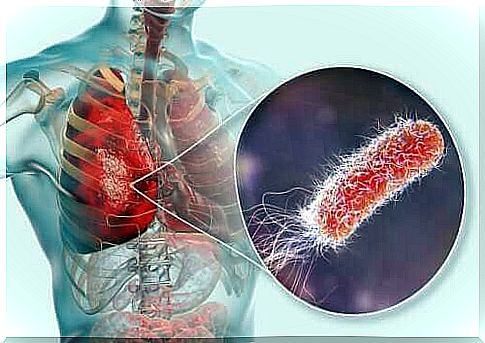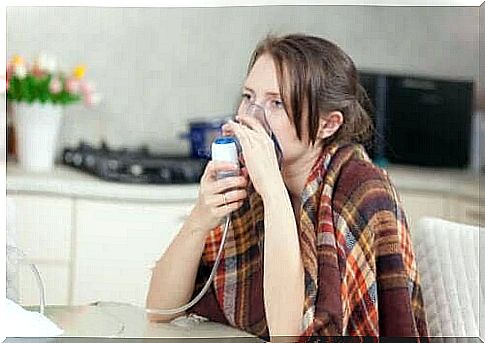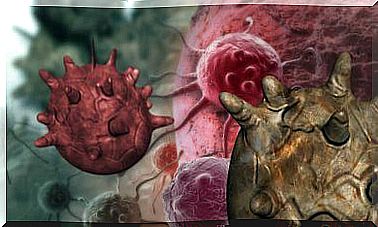Are There Bacteria In The Lungs?

Symptoms such as chest pain, shortness of breath, fever, nausea or vomiting are signs of bacteria in the lungs. Although these microorganisms are essential for the optimal functioning of human physiological systems, their presence in these types of organs can lead to diseases such as pneumonia.
Do you know why these bacterial infiltrations occur in the lung area? Are you in a risk group?
Knowing more about this is the key to dealing with these diseases, because we can take more preventive measures. Because of this, we will tell you everything you need to know about bacterial pneumonia in this article.
About microbiota and bacterial activity
First, it is important to remember that the bacteria in the human body are mostly positive. Various microbiological studies have gathered their benefits.
For example, bacterial colonies in the intestines perform functions such as:
- Better absorption of certain nutrients
- A more efficient lipid metabolism
- Protection against pathogenic microorganisms
The normal flora is defined as the set of microorganisms that live in the body of living beings and perform various functions of a symbiotic or degrading nature together with the host. These colonies have both a spatial and temporal component, as their composition and presence may vary depending on where they live in the body and the person’s age.
The problem comes when bacteria colonize internal systems that do not take advantage of their presence. This is the case with bacterial pneumonia, which we will explain below.

Are there bacteria in the lungs?
In general , the lung microbiota has its own healthy bacteria, but unhealthy bacteria can enter. Like any surface with external contact, areas such as the nasal cavity, nasal cavity and larynx have bacterial communities that are harmless to humans.
When these microorganisms enter the internal airways, it presents a clinical picture of pneumonia. This type of condition can happen to anyone, regardless of age or gender, although several statistical studies emphasize that it is more common in newborns.
In addition , HIV patients also have a special risk for this condition, as they are five times more likely to develop bacterial pneumonia than an HIV-negative person.
Why does bacterial pneumonia occur?
Bacterial pneumonia is usually caused by pneumococci. In fact, some studies show that 40% of cases occur because of this microorganism. However, it may also be present during colonization of other microorganisms such as:
- Haemophilus influenzae
- Klebsiella pneumoniae
- Escherichia coli
- Pseudomonas aeruginosa
- Moraxella catarrhalis
Bacteria usually reach the airways by inhalation, but they can also end up in the airways through the bloodstream if an infection has spread sufficiently to another area of the body. This is where the immune system sends white blood cells to fight disease.
Neutrophilic granulocytes surround bacteria with the membranes and release cytokines, thus promoting a typical clinical picture of bacterial infections. All this can be summed up in the fact that there is inflammation in the alveoli and respiratory tract.
Symptoms of bacteria in the lungs
Depending on the severity of the clinical picture and the causative microorganism, the symptoms may vary. That said, the following are general signs:
- chest pain when breathing and coughing
- disorientation
- fever
- productive cough with purulent expectoration
- nausea, vomiting and diarrhea

How Do Doctors Diagnose Bacterial Pneumonia?
According to information from the Pan American Journal of Public Health , the radiological picture of alveolar consolidation is accepted as a confirmatory criterion for suspected bacterial pneumonia. In affected patients, opacity in lung tissue is usually observed, but this is not always true.
In times of suspicion, the cultures of the patient’s expectorate can always be taken to confirm the presence of bacteria.
What is the treatment?
As in all cases of bacterial infections, antibiotics will be the medication of choice. After the doctor has decided whether they are gram-positive or gram-negative bacteria, the doctor may suggest the use of several medicines, such as amoxicillin, cephalosporins or doxycycline.
In the presence of varied treatments, it is necessary to determine the exact genus of the microorganisms that cause the disease. Thus, it is possible to choose the most effective therapeutic options for each case.
What to keep in mind about bacteria in the lungs
According to the Norwegian Institute of Public Health, there is in fact a vaccine against pneumonia caused by pneumococci, the most common disease. This is often recommended for infants under two years of age and adults over 65 years of age, as they are the typical vulnerable groups.
In addition, with the risk of getting it in another age group, the outlook is positive if treated early and there are no complications.
Bacteria are important microorganisms, as they protect against pathogens in many of the body’s systems. However, an uncontrolled condition can cause health problems. Therefore, if you think you have a bacterial infection, it is important to see a doctor immediately.









